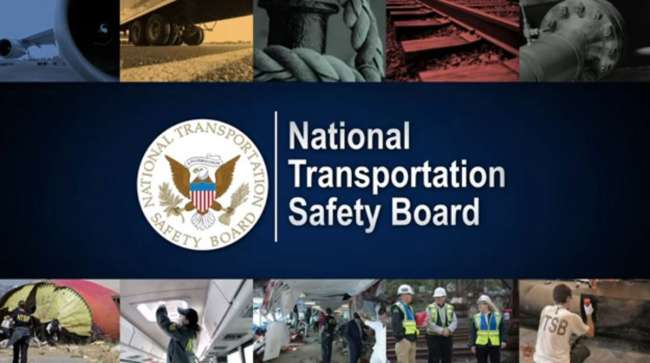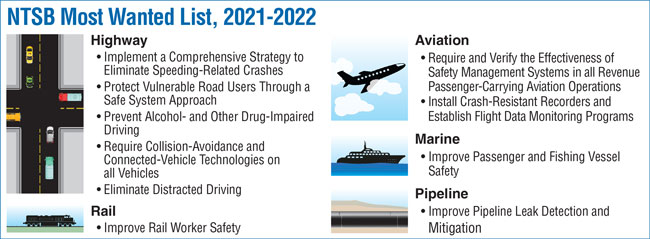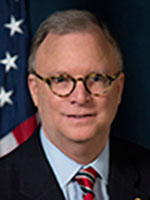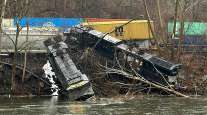Senior Reporter
NTSB Adopts New Most Wanted List of Safety Concerns

[Stay on top of transportation news: Get TTNews in your inbox.]
The National Transportation Safety Board’s new Most Wanted List of safety concerns contains several recommendations from 2019, including calling on automobile and truck manufacturers to develop a standard practice of installing collision-avoidance and connected-vehicle technologies in all vehicles.
The 2021-2022 list, adopted by the NTSB board of directors April 6, also listed priorities to implement a comprehensive strategy to eliminate speeding-related crashes, prevent alcohol- and drug-impaired driving and eliminate distracted driving.
The list identifies the biggest safety improvements that can be made across transportation modes including highway, pipeline, marine, air and rail.

Source: National Transportation Safety Board
The list was unanimously adopted formally by the board after more than four hours of staff presentations, and discussions and questions by board members.
NTSB is an independent federal agency that determines the probable cause of transportation-related accidents and promotes safety. The board has five members, each of whom is nominated by the president and confirmed by the Senate.
NTSB Chairman Robert Sumwalt said the staff recommendations and board’s final approval was “driven by data” and included issues that are “ripe for action.”

Sumwalt
“The Most Wanted List defines the focus of the NTSB’s advocacy work,” Sumwalt said. “It directs our limited advocacy resources toward improvements with the greatest potential to make the greatest impact on saving lives, reducing injuries, and preventing accidents and crashes.”
The list took into consideration the agency’s research and results of transportation-related accidents investigated by the board, particularly those involving speeding and distracted and impaired driving, large contributors to fatal crashes, according to Robert Molloy, director of NTSB’s Office of Highway Safety.
“Studies have shown that as many as 80% of crashes could have benefited from sensor-based collision-avoidance technologies such as automatic emergency braking and forward-collision warning,” Molloy told the board. “All vehicles should have these systems available as a standard feature.”
Other items on the board’s list included a requirement that crash-resistant recorders, flight-data monitoring programs, and safety management systems be installed on all passenger-carrying aviation operations.
In addition, the list called for improvements to rail worker safety, pipeline leak detection and mitigation, passenger and fishing vessel safety, and protection efforts for such “vulnerable road users” as bicyclists and motorcyclists. Fatalities for pedestrians and other road users are on the rise.
Want to learn more about the 2021-2022 Most Wanted List? Join us for our #NTSBmwl Twitter Chat on April 13 at 12pm ET. pic.twitter.com/V4skApG5Fs — NTSB (@NTSB) April 7, 2021
The April 6 meeting, during which the NTSB staff presented detailed past accident investigations to support the reasons for adding issues to the list, apparently was in reaction to criticisms by a federal government watchdog’s citing transparency issues.
In a report last year, the Government Accountability Office recommended NTSB require its team to document its evaluations for matters under consideration for its Most Wanted List.
Additionally, it said NTSB should proceed to publicly and fully communicate criteria used for labeling a specific transportation safety concern as “ripe for action.”
According to GAO, “If advocacy groups, industry associations and others don’t know why NTSB is advocating for these particular safety issues and recommendations, that could affect their attention to and support for tackling the issues on the list.”
“Greater transparency in how issues are evaluated and selected could enhance users’ understanding of the list and help ensure the list continues to rally the support and resources needed to tackle difficult and long-standing transportation safety challenges,” GAO said.
Sumwalt thanked his colleagues on the board for “the good debate and good discussion.”
“If anybody thinks these board meetings are scripted, then you hopefully have seen the board actually in our deliberations,” he said. “Nothing is pre-decisional. What you saw was our deliberations.”
Want more news? Listen to today's daily briefing below or go here for more info:




